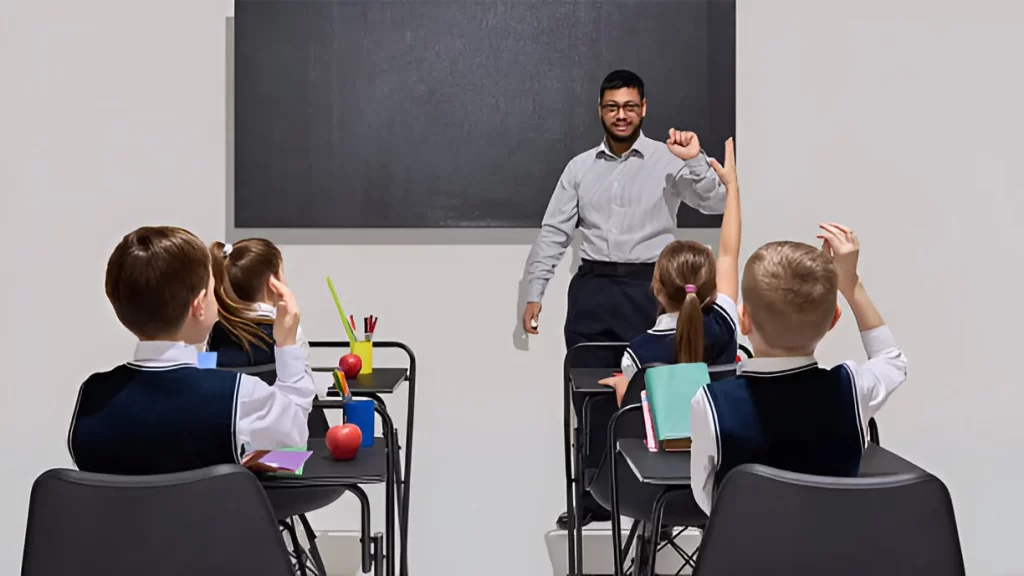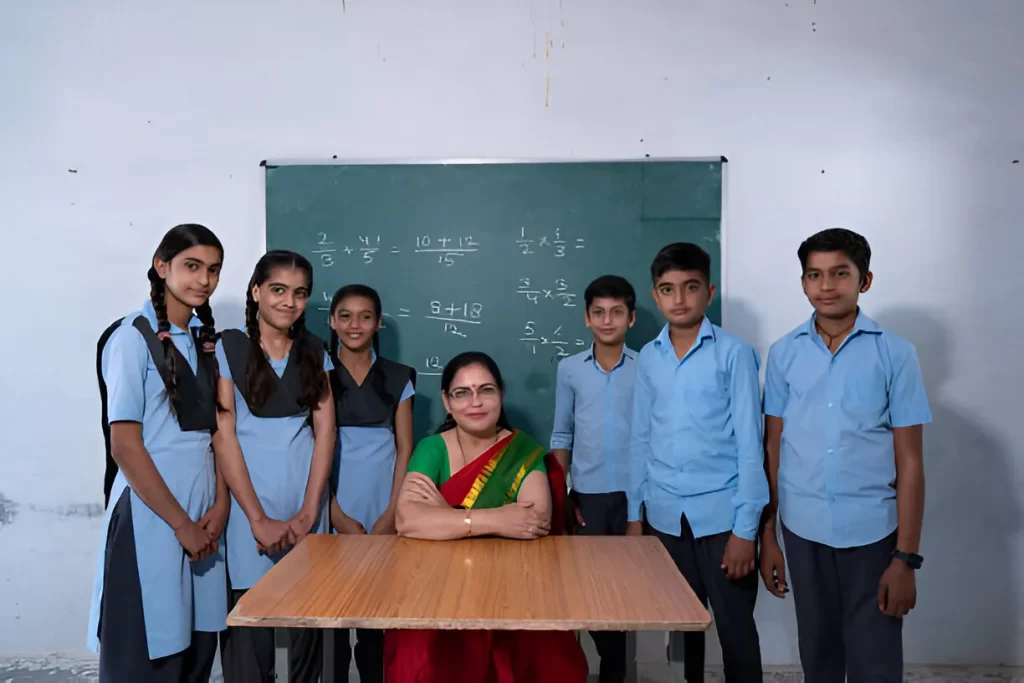Table of Contents
Have you ever stepped into an Indian classroom and felt the intensity? Desks lined up in perfect rows, students silent and focused, and a teacher whose words carry unquestionable authority.
Now picture an American classroom: vibrant, interactive, and relaxed—students in group discussions, questioning ideas, and teachers offering guidance more than commands.
These aren’t just random differences; they reflect two fundamentally different education systems shaped by cultural values, infrastructure, student-teacher dynamics, and government policies.
In this article, we go beyond surface-level comparisons to explore the real reasons Why Teachers in Indian Schools Are Stricter Than in the USA.
Backed by personal experience and deep research, we break down the key differences in teaching style, classroom behavior, student expectations, and system design to help you understand how two great nations approach education and discipline differently.
Student-Teacher Ratio: Managing the Masses vs. Guiding the Few

🇮🇳 In India:
A single teacher is often responsible for more than 50 students in one classroom. This makes it nearly impossible to offer individual attention.
With limited time and overwhelming numbers, teachers must maintain strict order just to deliver the lesson.
🇺🇸 In the USA:
Teachers typically handle 20–30 students per class, allowing for better classroom management and personalized attention.
The lower student-teacher ratio also enables educators to use interactive and creative methods instead of relying on strict control.
Conclusion: Indian teachers must be strict out of necessity. U.S. teachers have the luxury of being flexible.
Cultural Values: Authority vs. Autonomy
In India:
Teachers are traditionally regarded as “Gurus”, second only to parents. Disrespect is not tolerated, and obedience is a core virtue. Students are expected to follow instructions without questioning authority.
In the USA:
The relationship between teacher and student is more collaborative. Open dialogue is encouraged, and questioning ideas—even those of the teacher—is considered a part of learning.
Conclusion: In India, strictness upholds the culture of respect. In the USA, freedom fosters curiosity and independent thinking.
Read also: HCOOCH CH2 H2O
Curriculum Flexibility: Rigid Tracks vs. Student Choice
🇮🇳 Indian Education System:
- Fixed curriculum until grade 10.
- Mandatory subjects like math and science.
- Little to no room for choosing electives early on.
🇺🇸 American Education System:
- Students choose many subjects based on interest.
- Flexible course selection encourages exploration and creativity.
- Encourages alignment of learning with personal goals.
Result: Indian teachers need to keep all students on a strict, uniform academic path. American teachers guide students down individualized learning journeys.
Infrastructure and Resources: Scarcity vs. Advancement
In Indian Public Schools:
- Limited classrooms, outdated furniture, and a lack of digital tools.
- Overburdened staff with minimal tech support.
- Teachers often double as administrators or counselors.
In U.S. Public Schools:
- Government-funded infrastructure with smart boards, labs, and digital platforms.
- Support staff available (counselors, special educators).
- Professional development for teachers is ongoing and structured.
Conclusion: Indian teachers are often strict due to resource limitations. U.S. teachers can focus on creativity and emotional intelligence thanks to better support systems.
Teaching Qualifications and Training
India:
- Teachers can begin working after graduation or post-graduation.
- Practical classroom training is minimal.
- Limited exposure to child psychology or behavior management.
USA:
- Teachers must obtain a state license and undergo certification.
- Training includes psychological, behavioral, and diversity education.
- Continuous professional development is required.
Impact: U.S. teachers are trained to manage classrooms without authoritarian methods. Indian teachers often rely on traditional, stricter methods due to a lack of formal training.
Examinations and Academic Pressure
In Indian Schools:
- Frequent, formal exams starting in lower grades.
- Rote memorization is rewarded.
- Students and parents prepare for exams weeks in advance.
- Performance in a few major exams defines the academic future.
In U.S. Schools:
- Lower grades involve informal assessments like projects and quizzes.
- Tests contribute only a portion to the final grade.
- Creativity, participation, and continuous evaluation are encouraged.
- Major tests like the SAT/ACT come much later.
Result: Indian teachers enforce strict discipline to prepare students for high-pressure exams. U.S. educators foster stress-free learning environments.
Homework and Learning Load
India:
- Heavy homework load from early grades.
- Students carry bags filled with multiple textbooks.
- The focus is on completion, accuracy, and neatness.
USA:
- Lighter academic workload, especially in the early years.
- Emphasis on understanding over quantity.
- Books are often stored in schools; digital platforms are used.
Conclusion: Strictness in India ensures accountability for large amounts of content. In the U.S., the relaxed structure allows for conceptual learning.
Grading and Evaluation Systems
Indian System:
- 10+2+3 format (Bachelor’s degree in 3 years).
- Grades are heavily based on final exams.
- Limited consideration for homework, classwork, or projects.
- High scores in board exams are crucial for college admission.
American System:
- 10+2+4 format (Bachelor’s degree in 4 years).
- Grades are built over four years, including projects, assignments, and tests.
- GPA system emphasizes consistency over peak performance.
Effect on Teachers: Indian teachers must drill discipline to prepare students for high-stakes outcomes. U.S. teachers can nurture students over time with varied metrics.
Teaching Style and Classroom Behavior
In India:
- Classrooms are teacher-centric.
- Silence, stillness, and note-taking are valued.
- Rules are enforced rigidly; discipline is non-negotiable.
In the U.S.:
- Classrooms are student-centric.
- Engagement, discussion, and collaboration are encouraged.
- Students participate in shaping the class atmosphere.
Bottom Line: Indian teachers are strict to maintain control. American teachers act as facilitators and guides.
Social Skills and Emotional Development
Indian System:
- Limited attention to personality development or emotional intelligence.
- The focus is on academic excellence.
- Creativity, social skills, and mental health are often overlooked.
American System:
- Strong focus on well-rounded development.
- Emphasizes group projects, presentations, sports, and arts.
- Teachers are trained to identify and support students’ emotional needs.
Result: U.S. students may be more socially and emotionally prepared for real-world challenges. Indian students excel in core academics but may struggle with communication or confidence.
Respect vs. Relationship
In India, the student-teacher relationship is built on formal respect, discipline, and hierarchy. Teachers rarely socialize with students or act informally.
In the U.S., the relationship is friendlier and more open. Teachers may share jokes, offer mentorship, and even learn from students.
This influences classroom tone: Indian teachers maintain strict boundaries, while American teachers aim to build trust and connection.
Entrance Exams and Career Pressure
India:
- Entrance exams like NEET, JEE, UPSC, and CAT decide career paths.
- Huge societal pressure to succeed academically.
- A career is determined early, often by parents or social norms.
USA:
- Exams like the SAT, ACT are just one part of college applications.
- Focus on overall profile—extracurriculars, volunteering, essays.
- Students have more freedom to explore different career paths.
Effect: Indian teachers become strict gatekeepers to professional success. American teachers are mentors guiding students toward future options.
Final Words
The strictness of Indian teachers is not about being harsh; it’s about delivering results in a system where academic success is seen as everything.
Overcrowded classrooms, rigid exams, cultural expectations, and limited resources force teachers to adopt a disciplined, no-nonsense approach.
On the other hand, U.S. teachers operate within a system that values creativity, emotional development, and flexibility.
With fewer students, more support, and a culture that respects individuality, they can afford to be less strict and more nurturing.
Both systems produce world-class professionals. But if we can combine India’s academic rigor with America’s developmental focus, we may just create the ideal learning experience—disciplined yet free, focused yet flexible.






